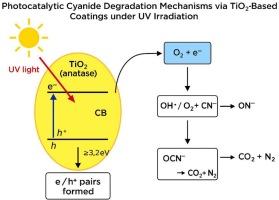二氧化钛基光催化剂对含有毒氰化物废水的解毒研究
Q1 Environmental Science
Environmental Nanotechnology, Monitoring and Management
Pub Date : 2025-07-11
DOI:10.1016/j.enmm.2025.101087
引用次数: 0
摘要
工业、农业和家用化学品日益污染环境,即使浓度很低也会影响水、空气和土壤。这种污染,特别是来自废物的污染,是一个严重的全球性问题。使用可再生能源,如阳光和光催化剂,提供了一种环保的方式来去除污染物。创新的重点是使用V, Er和ce掺杂的多层马赛克结构TiO2薄膜涂覆在合适的带隙值的玻璃基板上,以提高传统TiO2光催化剂的性能和可持续性,从而在日光/紫外光下有效处理含氰废水。本研究旨在利用溶胶-凝胶技术在玻璃基板上制备V, Er, Ce纯/掺杂TiO2薄膜,并利用这些基板光催化降解废水中的氰化物。研究了所制备薄膜的结构、微观结构和电学性能,并将其涂覆在玻璃基板上作为光催化剂,在紫外/太阳光源下光催化降解废水中的氰化物。作为一种创新的方法,实验室和工业规模的TiO2, V-TiO2, Er-TiO2和Ce-TiO2涂层具有锐钛矿相在玻璃基板上呈现多层马赛克结构。涂层的折射率、膜厚和能带分别在1.6028 ~ 1.6075 nD、2.408 ~ 2.750 μm和3.08 ~ 3.73 eV范围内变化。值得注意的是,使用这些改性TiO2薄膜降解废水氰化物的效率达到95%,这表明它们在环境修复中的高性能光催化应用潜力巨大。光催化样品在10个工业规模循环中证明了有效的氰化物降解,由于实际废水中的杂质堆积,效率下降。清洁表面恢复了活性,突出了材料的可回收性潜力。因此,这一创新提供了高达95%的氰化物去除效率,通过表面清洁可重复使用和可持续性,并具有工业规模的适用性。本文章由计算机程序翻译,如有差异,请以英文原文为准。

Detoxification of wastewater with toxic cyanide substance using TiO2-based photocatalysts
Industrial, agricultural, and domestic chemicals increasingly pollute the environment, affecting water, air, and soil even at low concentrations. This pollution, especially from waste, is a serious global problem. Using renewable energy like sunlight with photocatalysts offers an environmentally friendly way to remove pollutants. The focus of the innovation is the use of V, Er, and Ce-doped, multilayer mosaic-structured TiO2 thin films coated on glass substrates with their suitable band gap values to enhance the performance and sustainability of traditional TiO2 photocatalysts for the effective treatment of cyanide-containing wastewater under sunlight/UV light. In this study, it was aimed to produce V, Er, Ce pure/doped TiO2 thin coatings on glass substrates with sol–gel technique and photocatalytic degradation of cyanide in wastewater by using these substrates. The structural, microstructural and electrical properties of the produced films were investigated and thin films coated on glass substrates were used as photocatalysts in the photocatalytic degradation of cyanide in wastewater under UV/sun light source. As an innovative approach, laboratory and industrial scale TiO2, V-TiO2, Er-TiO2, and Ce-TiO2 coatings with the anatase phase on glass substrates exhibit a multilayered mosaic architecture. The coatings’ refractive index, film thickness, and energy bandgap were observed to vary within the ranges of 1.6028–1.6075 nD, 2.408–2.750 μm, and 3.08–3.73 eV, respectively. Notably, a 95 % efficiency was achieved in cyanide degradation from wastewater using these modified TiO2 films, indicating their significant potential for high-performance photocatalytic applications in environmental remediation. Photocatalytic samples demonstrated effective cyanide degradation over 10 industrial-scale cycles, with efficiency declining due to impurity buildup from real wastewater. Cleaning the surface restored activity, highlighting the material’s potential for recyclability. As a result, this innovation offers up to 95 % cyanide removal efficiency, reusability and sustainability through surface cleaning, and applicability at industrial scale.
求助全文
通过发布文献求助,成功后即可免费获取论文全文。
去求助
来源期刊

Environmental Nanotechnology, Monitoring and Management
Environmental Science-Water Science and Technology
CiteScore
13.00
自引率
0.00%
发文量
132
审稿时长
48 days
期刊介绍:
Environmental Nanotechnology, Monitoring and Management is a journal devoted to the publication of peer reviewed original research on environmental nanotechnologies, monitoring studies and management for water, soil , waste and human health samples. Critical review articles, short communications and scientific policy briefs are also welcome. The journal will include all environmental matrices except air. Nanomaterials were suggested as efficient cost-effective and environmental friendly alternative to existing treatment materials, from the standpoints of both resource conservation and environmental remediation. The journal aims to receive papers in the field of nanotechnology covering; Developments of new nanosorbents for: •Groundwater, drinking water and wastewater treatment •Remediation of contaminated sites •Assessment of novel nanotechnologies including sustainability and life cycle implications Monitoring and Management papers should cover the fields of: •Novel analytical methods applied to environmental and health samples •Fate and transport of pollutants in the environment •Case studies covering environmental monitoring and public health •Water and soil prevention and legislation •Industrial and hazardous waste- legislation, characterisation, management practices, minimization, treatment and disposal •Environmental management and remediation
 求助内容:
求助内容: 应助结果提醒方式:
应助结果提醒方式:


